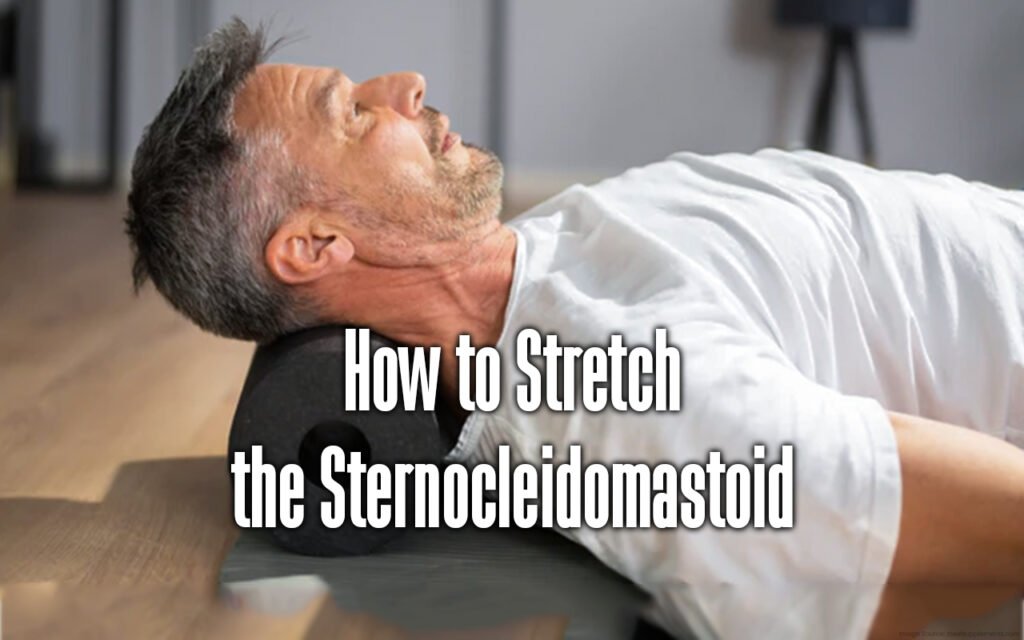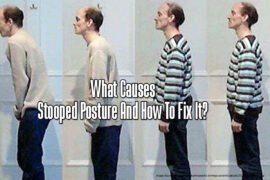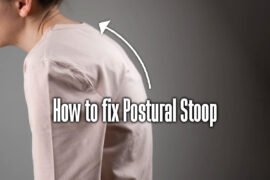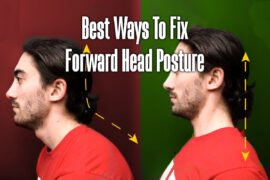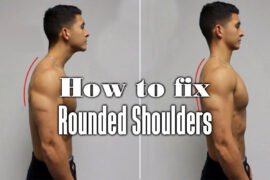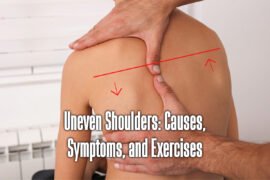Do you experience neck discomfort at your job and you wake up with a stiff or painful neck and you experience neck tightness and strain every night, preventing you from sleeping?
If you say “yes” to any of these questions, you may benefit from stretching your Sternocleidomastoid, a significant neck muscle prone to strain and tension. People who suffer from neck tension, headaches, pain, or stiffness often have trigger points.
If you don’t work to alleviate the tension in your Sternocleidomastoid muscle, your neck problems will only worsen. Furthermore, a tight Sternocleidomastoid can weaken your posture and make you develop a forward head posture.
Continue reading if this describes you and you want to understand how to stretch this muscle to enhance your mobility and correct your head posture.
What is the Sternocleidomastoid?
Table of Contents
The Sternocleidomastoid is a muscle on both sides of the neck that aids in virtually all neck motions. As you look sideways, nod up and down, and tilt your head from side to side, it shortens and lengthens. It also helps to keep your head steady while walking and doing other physical activities. The muscle referred to as the Sternocleidomastoid starts at the base of your skull, near the Mastoid bone (located behind each ear), and extends down both sides of your neck until it meets up with your collarbone.
Forward Head Posture
So how does a shortened Sternocleidomastoid muscle contribute to forward head posture?
A forward head posture means your neck is holding your head out in front of your torso rather than having your head aligned directly over your shoulders.
People with an excessively curved upper back, or thoracic kyphosis, are more likely to develop this posture. People who frequently strain their necks by looking down at a laptop, mobile device, desk computer, or steering wheel for extended periods are more likely to develop it.
Holding your head in these positions is a problem because the muscles will adapt to the new place. Tmuscles begin to hold your head forward when you become accustomed to doing so, and with time, your spine’s curvature may also change.
The Sternocleidomastoid muscle of your’s is shortened and tight when you have a forward head posture. The head will remain lowered and facing forward in this position. If you want to improve your forward head posture, gradually lengthen your Sternocleidomastoid with frequent stretches and releasing trigger points.
Benefits of Stretching Your Sternocleidomastoid
The benefits of stretching the Sternocleidomastoid muscles at the front and sides of your neck are extensive.
Not only does it protect and heal your physical health, but it also boosts your mood and improves brain function. In addition to stretching, here are some more benefits of working this critical muscle.
Improves Your Posture
You can reverse the misalignment if you stretch your Sternocleidomastoid muscles regularly and have an excellent forward head posture.
Rarely do forward head posture issues occur in isolation from other postural problems. One way to improve your posture is by stretching your Sternocleidomastoid muscle and aligning your head with your torso.
Fights Neck Pain
Stretching, self-massage, and myofascial release are all excellent ways to relieve neck pain caused by a strained Sternocleidomastoid muscle.
Neck pain often occurs after the tightness has been released, immediately or when you wake up the following day.
Regularly performing a neck stretching routine can alleviate or prevent neck pain by loosening tightness and relieving strain.
Relieves Stiffness and Improves Range of Motion
When you stretch, it allows your muscles to lengthen after being shortened from contraction. The weight of your head causes the Sternocleidomastoid muscles to contract when you have a forward head posture.
When you stretch, it lengthens your neck muscles, allowing your head a more excellent range of motion. Not only does it loosen the tension, but it also relieves discomfort-causing stiffness.
Boosts Blood Supply to the Brain
When you stretch, your muscles can absorb fresh oxygen and nutrients from the bloodstream. When your neck muscles, such as your Sternocleidomastoid, are excessively tight, it can interfere with how your brain functions and affect your mood and cognitive performance.
Stretching your Sternocleidomastoid muscles improves blood flow and increases muscle flexibility, which supplies the brain with more oxygen and nutrients.
This can significantly lower your stroke risk, which can occur when the brain doesn’t receive enough blood flow.
How do you know if your Sternocleidomastoid Muscle is Tight?
Your Sternocleidomastoid muscle is too tight if you have pain or stiffness in your neck. Another common symptom is jaw pain, along with headaches.
If you have poor posture, mobile device neck syndrome, or spend prolonged periods at a desk or laptop, you’re more likely to experience neck tightness.
The muscle in your neck, called the Sternocleidomastoid, is most popularly shortened from always having poor posture with your head looking down—better known as “text neck.”
Tests for Neck Tightness
You can test whether your neck is overly tight or shorter. The Sternocleidomastoid muscle has to be released and stretched if any of these tests reveal that your neck is tight.
- Gently pinch each side of your Sternocleidomastoid and feel along its length for any trigger points. To indicate that the tissue fibers are tense and knotted, trigger points are minor, isolated locations that become more painful or sensitive when squeezed.
- Turn your head left and right. If you often experience limited movement or pain while completing specific tasks, Sternocleidomastoid tightness may be to blame.
- Start by stretching your neck upwards, then downwards to target both the front and back of your neck. When you have limited mobility, it’s a clear indication that your Sternocleidomastoid is shortened and in need of stretching.
How to Create Length in Your Sternocleidomastoid
The most effective way to stretch this muscle is by doing myofascial release first to remove any trigger points causing chronic tightness.
After you warm up, it’s time to start stretching to create more length in your muscles. Keep in mind that these processes are not one-time tasks. It is essential to do neck stretches regularly if you never take time out to stretch your neck.
1. Myofascial Release for Your Sternocleidomastoid
Myofascial release releases trigger points in the thin layer of connective tissue called fascia that surrounds your muscles and keeps them isolated from bones and other muscles.
The fascia, a web of fibers connecting muscle tissue throughout the body, can get as tight and knotted as the muscles it overlays.
Myofascial release may be helpful if you have trigger points in your neck, as many trigger points are likely located in the fascia layer of tissue.
Myofascial release is frequently performed with self-massage instruments like foam rollers and massage balls, which compress and knead the fascia to release trigger points.
If you want to release the fascia around your Sternocleidomastoid muscle, try using a massage ball or your hand.
Massage Ball Sternocleidomastoid Release
Standing up or resting on your front, you can massage your Sternocleidomastoid with a massage ball. The video above shows the lying-down version.
- Put a towel or rolled-up yoga mat beneath your right armpit while you recline face-down on the mat.
- For this particular massage, you’ll want to place your ball on top of a rolled-up mat or towel so that it’s right under your Sternocleidomastoid neck muscle (the large one on the right side of your neck).
- To massage the muscle fibers and exert pressure on trigger points, tilt your head slowly up, down, and side to side.
Sternocleidomastoid Massage Release by Hand
The video above demonstrates how to release the Sternocleidomastoid muscle using only your hand if you don’t have a massage ball.
- To find your Sternocleidomastoid muscle, look on one side of your neck for where it starts at the bottom of your collarbone. To locate it, turn your head in the opposite direction to the side you’re looking for, and feel for the bulging band-like muscle that runs the length of your neck.
- Gently massage your neck muscles, starting from your collarbone and working your way up, slowly pinching the band and feeling for trigger points.
- Press down on the muscle or use your fingers to pinch it when you find a trigger point. You will know the trigger point has been released when you feel immediate relief and lose tension after letting go of the pressure.
- Repeat on the opposite side.
2. How to Stretch Your Sternocleidomastoid
Your Sternocleidomastoid is a large, thick muscle that resembles a band; by stretching it in various ways while focusing on your neck, you can extend the muscle and release stress.
Given its unusual way of attaching to two separate body sections, it’s also not the most accessible muscle to stretch; thus, mastering this technique could take some time.
If you’re looking for stretches to do for your Sternocleidomastoid, here are 2 options:
Seated 30-Degree Rotation Side Stretch
- Sit up straighter in your chair and look 30 degrees to the right.
- To do this neck stretch, grab your right arm with your left hand and then use it to tilt and pull your head until you feel a stretch.
- Hold this position for 10 seconds, then carefully switch sides.
Head Tilts
- Your shoulders should be relaxed, and you should sit up straight.
- Gently lower your head to your right shoulder, stretching the muscles on the left side of your neck.
- In order to feel the stretch more deeply, lightly push the left side of your head.
- Return to the center after holding for 10 seconds.
- Repeat the process on the left side.
- Do 10 repetitions on each side.
Taking Care of Your Neck and Avoiding Neck Conditions
A correctly aligned spine is crucial for overall health, and neck and head alignment are vital components. Postural issues with your spine can cause some very severe problems down the line. If your spinal disks experience too much strain due to extreme curvature in the spine, it can cause disk herniation and degenerative disk disease.
To avoid neck pain, taking care of your neck muscles and relieving tension before it becomes a chronic problem is essential. Regular stretching of your Sternocleidomastoid muscle will assist prevent forward head posture from becoming a source of pain and health issues.
Keep ahead of tightness with self-massage and trigger point release if you feel it is beginning to return. Not only is it essential to maintain good hygiene when taking care of your neck, but improving your posture and making sure your desk is ergonomic are crucial as well.
Consider using a back brace to help correct the alignment if you have thoracic kyphosis or hyperhidrosis because it makes it easier for you to adjust your forward-head posture. To eliminate neck pain, address the problem’s source by improving your neck posture and reducing muscle tension.
Without treating your neck tightness, stiffness, or pain at its source, the problem will only worsen. Releasing and stretching the Sternocleidomastoid muscle is a great way to eliminate neck pain and correct forward head posture.
Remember that you must practice this program frequently if your neck is tight. This realistic option may only partially fix the problem; however, it will hopefully manage pain and prevent further issues.
If any neck exercises worsen your pain, discontinue those exercises immediately. A professional will always be able to understand your case better than trying to treat it yourself.


